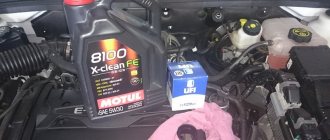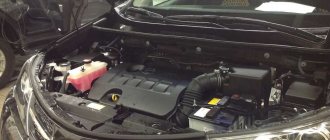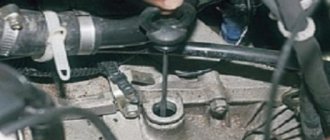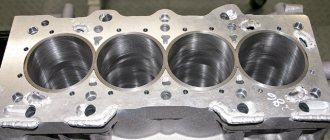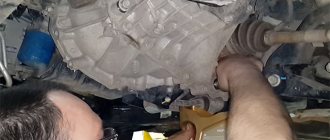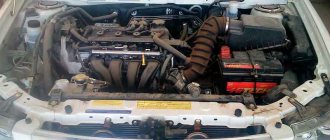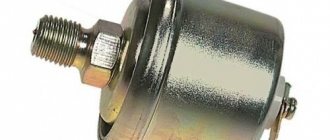Toyota Corolla 150 is a Japanese C-class car, produced from 2006 to 2012. It was produced in sedan, hatchback and station wagon bodies. On the Russian market, the car was known with 1.4 and 1.6 liter gasoline power plants, which developed 97 and 124 hp. With. respectively. In 2010, restyling took place. By that time, a 1.3-liter 100-horsepower engine appeared instead of the 1.4 engine. In Europe, the car was also sold with 1.4-2.2 liter diesel engines (90-176 hp). In Japan, the 10th generation Corolla (120) was equipped with 1.5 and 1.8 liter gasoline engines, with a power of 110 and 136 hp. With. respectively. In the USA, the car was available with 1.8 (132 hp) and 2.0 liter (158 hp) gasoline engines.
Regulations for changing oil in manual transmission
According to the recommendations of experienced car owners and specialists, the oil in the Toyota Corolla 150 manual transmission must be changed every 50-100 thousand km. Subject to certain conditions specified below, it is sufficient to adhere to the specified regulations:
- The car is operated in a mixed cycle, that is, highway mileage corresponds to city mileage, and increased loads on the car are excluded (driving at maximum speed and transporting heavy loads)
- The gearbox operates without jerking or jerking, gears are engaged clearly and without any hard effort
- Only high-quality gear oil is used
- During operation, diagnostics are carried out for the presence of oil leaks at the seals. As a last resort, the seals are changed if their tightness is broken. Otherwise, water may penetrate through the seals, which will subsequently enter the gearbox and become a source of corrosion. In addition to replacing the seals, it would not be superfluous to rinse the gearbox from wear debris and add fresh oil.
What is the function of transmission oil?
All modern automobile oils, both those used in engines and transmissions, consist of a base and a set of additional compounds - additives. Basically, the quality of the lubricating function is determined by the base, and the additional additive package only corrects and improves its performance characteristics.
Transmission systems, in addition to lubrication, have another important task. When the manual transmission gears in mesh rotate, a large amount of heat is generated. In the box of a moving car, the temperature fluctuates within 150 degrees Celsius, while at the very point of contact of the gears it can rise to 300 degrees. The oil poured into the manual transmission also performs a heat-removing function, while cooling the parts and preventing critical overheating of the box.
Necessary components for work
To replace the transmission, it is not oil that is used, but a special composition intended specifically for this unit. The container label for this liquid bears the designation ATF (automatic transmission fuid). This liquid is able to function under more difficult conditions, withstanding significant loads. When the gearbox is operating, the operating temperature of the parts reaches 300-400*C.
The torque converter experiences heavy loads: when the car is moving, the temperature of the systems reaches 150*C. During long-term operation of the gearbox, volatile components evaporate from the solution used for lubrication and cooling, and the composition of the transmission fluid changes, which is unacceptable.
The fluid poured into the Toyota Corolla automatic transmission performs a dual function:
- heat removal from the box parts to the external environment;
- lubrication of contacting parts.
To stabilize the solution at high temperatures and stabilize ongoing processes while preventing oxidation, special additives are added that prevent wear of parts and allow mechanisms to function normally at temperatures from -40* to +150*C.
During long-term operation of the gearbox, volatile components evaporate from the fluid used for lubrication and cooling, and the composition of the transmission fluid changes, which is unacceptable for the normal operation of the mechanisms. READ MORE:
None When completely replacing auto fluid, it is imperative to determine the labeling of all the necessary components that may be needed for replacement: oil filter, O-rings and gaskets.
Typically, synthetic solutions used for transmission are 2-3 times more expensive than mineral solutions. It must be taken into account that fluids are poured through the level measurement hole in the gearbox, and in some brands of cars using a control plug in the automatic transmission box.
Transmission fluid markings
Experienced drivers of cars with a manual transmission have the opportunity to experiment with lubrication in the gearbox, but for car owners of cars with an automatic transmission this is unacceptable.
It must be taken into account that in automatic transmissions oil is used not only to reduce friction or remove heat and products of mechanical wear of gears, but also as a hydraulic element that transmits torque.
Therefore, if you don’t think about what kind of oil to pour into the automatic transmission, but use the wrong fluid for this, you will soon end up with a broken transmission.
The main source of information in this situation is the technical documentation for the car. The manufacturing company must indicate the specific brand and type of automatic transmission fluid. In some cases, the use of analogues is allowed , but they must have the same formula and physical and chemical properties to ensure the performance of torque converters and gearboxes.
The following functions are assigned to transmission lubrication:
- the main task is to transmit torque from the engine to the transmission elements;
- reducing the coefficient of friction between contacting elements;
- heat removal from rubbing units;
- control of the box through a hydraulic system;
- reducing the intensity of corrosion processes.
To ensure all conditions and operating temperature conditions, high-quality raw materials are required during production. With such a base, various additives are used to reduce foaming, prevent oxidation of the liquid, etc.
To know that you need to fill a Toyota, Nissan, Renault automatic transmission or products from other auto companies into the box, you will need to understand the markings of transmission fluids. There are several classifications accepted as standards.
Some of the reputable companies in this area are American manufacturers General Motors Co and Ford. Both laboratory standards differ in the characteristics controlled.
GM is promoting the ATF (Automatic Transmission Fluids) standard. Production is carried out at the request of auto companies by leading oil refining concerns. The products on the market are represented by the brands Type F, Mercon and Dexron. The basis for them is mineral, semi-synthetic and synthetic materials.
Oil manufactured to Ford standards is based on different criteria. The updated classification was named Ford New Mercon .
ZF TE-ML markings are popular on the European continent. This standard includes almost all fluids used during the operation of hydromechanical gearboxes.
How often do you change transmission oil?
At high temperature loads, the oil begins to foam, and at the same time its lubricating characteristics are significantly reduced. Also, during operation, additives burn out, which in turn impairs the performance of the protective function. The result of untimely replacement of the lubricant is the formation of scuffing on the main gear - during operation, its gears begin to emit a peculiar buzzing sound; after 500-1000 kilometers, the teeth of the transmission parts cannot withstand the increased load and begin to collapse. If appropriate measures are not taken, the Corolla's manual transmission may jam or completely fail.
The 2008 Toyota Corolla is a front-wheel drive car whose manual transmission is subject to the greatest load, unlike rear-wheel drive cars. In order to maintain the performance of the transmission for a long time, a scheduled oil change should be carried out every 50-60 thousand kilometers, and for aggressive driving or for cars participating in racing, this period should be reduced to 30-40 thousand.
When to change the oil in a Toyota Rav 4 automatic transmission
The Japanese crossover was equipped with two types of automatic transmissions:
- A continuously variable transmission was combined with 2 liter engines. For the Japanese brand, this is a classic unit that has been in use for the second decade. The variator has proven itself on the positive side - as an unpretentious and relatively reliable device. Such a system cannot adequately handle high torque, which is why it was combined with a less powerful motor. However, changing the automatic transmission oil of Toyota Rav 4 2007 in such a device is not provided for by the manufacturer at all. According to the manufacturers, it is designed for the entire service life of the vehicle. In practice, due to its technical features, this unit is rarely physically able to overcome the 250,000 km mark without serious repairs and preventative maintenance. Therefore, experienced owners do not comply with the established regulations, but carry out the first fluid change after 60 thousand kilometers. This procedure, on such a short mileage, will preserve the original properties of the entire system, as well as extend the operation of the unit to the stated level. Most often, during the first change, the oil is partially topped up. However, in this case, the owner must necessarily use factory products.
- The classic torque converter automatic was intended for more powerful versions with a volume of 2.5 liters. The transmission in this version is highly reliable, there are 6 stages, a classic dipstick without newfangled control plugs is used to measure the oil level for the Toyota Rav 4 automatic transmission. The service life of the entire unit is stated to be 250,000 km, and with timely replacement of products and appropriate care, coupled with a calm driving regime in relatively moderate weather conditions, achieving such a resource will not be difficult. According to the regulations, the first change of substance in the box should be made after 130-150 thousand mileage, together with the oil filter. However, in this case, the owners reduce this interval by at least half. At the same time, the first replacement is also often carried out in the form of partial addition of fluid with the obligatory use of the original factory product and with a change of the oil filter. In addition, the first generations used a similar division into a variator and a torque converter gearbox, but the latter had only 4 stages - its design was more reliable and simple compared to a modern product.
The manufacturer, regulating the long terms for changing the automatic transmission oil of the Toyota Rav 4 2008, assumes ideal conditions for using the units - the absence of heavy loads, exposure to low temperatures, as well as careful operation. It is almost impossible to achieve this in real operation, and an automatic transmission, due to its design complexity, is inferior to its mechanical competitor in the overall level of reliability.
Important! Whenever changing or adding fluid, you must use a quality product.
Features of choice
All presented products are divided into three large groups: mineral, semi-synthetic and synthetic oils. The first ones are made from oil. They have the lowest cost, and are used in old cars from the 90s to the 70s. If you have a modern foreign car manufactured in 2000 (and later), then it is recommended to use synthetic or semi-synthetic products.
Such oils (unlike mineral oils) have many advantages, including:
- High thermal and chemical stability.
- Higher turnover.
- Resistance to temperature fluctuations.
- Long service life.
- Better penetration.
Synthetics promote the formation of a denser film on the surface of parts, which significantly reduces wear.
If funds allow, order original products from the manufacturer. It is necessary to use TOYOTA Getriebeoil LV 75W, since it was created specifically for this car model and, accordingly, will provide high-quality protection for gearbox components. If these products are too expensive, you can take a closer look at more affordable analogues. Car owners celebrate products from Castrol.
Checking the gearbox oil level
When operating vehicles, the level of transmission oils in manual transmissions decreases, so in addition to replacement, they should also be topped up regularly. Reasons to check the level are any signs of change in transmission performance. Checking the level and then adding oil are simple operations that you can do yourself.
Work order:
- The car must be placed on a flat horizontal surface above the inspection hole or raised using a lift. Checking the level should be done no earlier than 10 minutes after the vehicle has come to a complete stop, with the engine turned off.
- The surface of the gearbox should be cleaned around the level plugs and breather to prevent dirt from getting inside.
- Unscrew the cap and be sure to wipe it clean.
- Check the oil level - it should reach the bottom edge of the level plug hole.
- If the level is insufficient, unscrew the breathing valve (breather) located at the top of the manual transmission.
- Topping up should be done through the hole in the breathing valve in small portions until oil flows out of the hole for the level plug. For topping up, you can use a funnel and a suitable sized hose.
- Screw the plug into place and tighten it with the required force.
- Reinstall the breather.
Preparation, tools and replacement
The preliminary stage is studying the safety precautions for servicing a car, as well as preparing tools. Changing the oil in a Toyota Corolla E150 manual transmission is carried out in special clothing and protective gloves, as well as in a sufficient level of lighting. Before performing the procedure, you must allow the car to cool for 20 minutes.
- screwdriver, wrenches, and hex keys;
- an ordinary watering can and a half-meter hose;
- special gaskets for filler and drain holes;
- free container for draining used consumables.
Step-by-step instruction
After purchasing a new consumable, you need to prepare the tools and garage space for the oil change procedure in a 2008 Toyota Corolla box.
- First of all, we drive the car into the “pit”, remove the protection and dismantle two plugs: drain and filler, and then drain the old lubricant into an empty container.
In order to remove the protection, you will need a 17-size wrench, and to remove the plugs, you will need a 24-size wrench. On the dismantled plugs, the car owner may see a warning about the need to first study safety precautions. The spent consumables are completely drained within 20 minutes.
- After draining, we evaluate the condition of the lubricant.
If chips appear, rinse and clean the tray. As a rule, the color of the drained lubricating fluid is practically no different from the new one, otherwise there is a malfunction in the operation of the gearbox. The drain plug on the model in question is not equipped on the inside with a special magnet that effectively collects chips, as in cars of other brands.
- Then you need to tighten the plug on the drain hole.
Next, using a watering can and hose, you need to pour new fluid into the filler hole.
- Be sure to check the oil level in the box; lubricant should be at the bottom edge of the filler hole.
Upon completion of the oil renewal procedure in the Toyota Corolla E150 manual transmission, you should tighten the filler cap and also return the protection to its place.
Operating procedure
Changing the oil in an automatic transmission of a Toyota Corolla 120 or 150 series practically does not differ in the procedure for carrying out the work. Place the car on a viewing hole or lift, and lock the parking brake. Next, it is necessary to carry out such operations.
- Place a container for used oil.
- Unscrew the drain plug located in the pan. After waiting for the technical fluid to drain, do not remove the container, since a certain part of the oil will be in the pan.
- Unscrew the bolts holding the automatic transmission pan. They are located along its perimeter. After unscrewing the pan, lower it without changing its position, since there is oil inside. Drain.
- Remove the three bolts holding the oil filter.
- Clean the inside of the pan and the magnets from any remaining oil and small particles.
- Install a new filter.
- Tighten the oil filter bolts to 11 Nm.
- Install the pan gasket without distortion on a clean, grease-free surface.
- Tighten the bolts holding the pan to 5 Nm. Less force can lead to oil leaks, and more force can lead to overtightening of the rubber gasket, which will also lead to leakage.
- Install a new O-ring under the drain plug and tighten it to a torque of 17 Nm.
- Using a funnel and hose, pour in about 4.5 liters of technical fluid.
- Disconnect the hose connecting the crankcase and the oil cooler.
- Place a transparent hose on the end of the metal tube coming from the automatic transmission.
- Start the car and drain until fresh raspberry-colored oil comes out.
- Fill in exactly as much as was drained the second time.
The oil change presented above in a Toyota Corolla 150 automatic transmission assumes a small residual technical fluid inside the box. Therefore, it most likely cannot be classified as a complete replacement procedure. To extract 100% oil from an automatic transmission, it is necessary to use factory vacuum devices, but this is not practical.
Sources:
- razborov.net
- corollacar.ru
- rulikoleso.ru
Changing the gearbox oil
Changing the oil in the manual transmission of a Toyota Corolla is also a fairly simple job. To complete this task you need:
- Drive the car for a short time to allow the transmission to warm up.
- Drive into the inspection hole or remove the left wheel by placing the car on a jack.
Attention! Some of the work will be done under the car, so install hemp under the car for your safety.
- Unscrew the drain plug (bolt) and drain the used oil into any suitable container. If the car has been used, the oil will be a little warm.
- You must wait until it drains completely. The remaining sediment can be additionally sucked out with a syringe with a curved tip.
- Next, we need to unscrew the second bolt, which we will initially reach not from below, but from above. It can be seen under the air duct that runs from the air filter to the engine.
- We unscrew this bolt, we will fill new oil through this hole.
- Reinstall the first bolt (drain plug) and tighten it securely.
- To add oil you will need a long funnel. We insert it into the hole where the second bolt was located.
- We fill in new transmission oil.
- We tighten the second bolt back.
Do-it-yourself oil change in a mechanical transmission (MMT, manual transmission)
The oil in a Toyota Corolla manual transmission is changed after 40,000 km or after four years of operation. Everything is described sequentially in the instruction manual.
The procedure for changing the oil in a manual transmission of this car model is much simpler than changing it in an automatic transmission. But you will have to buy and use a different gear oil.
Rice. 10 Oil for replacing manual transmission Toyota Carolla
And access to the manual transmission filler plug is no longer from below, but through the removed left wheel. There is no filter in the mechanical box. If the drained liquid has completely lost color and transparency, then the next replacement can be made a little earlier than the recommended period.
Rice. 11 Filler (aka control) plug for Toyota Corolla manual transmission
The drain plug looks the same as the filler plug. Access to it from below and slightly from the side; it is rotated 90 degrees relative to the filler.
The process of filling new oil into a manual transmission is complicated by inconvenient access to the filler neck and its small size. We have to invent something similar to a hospital IV. We hang an inverted plastic bottle with the bottom cut off from the back of the hood. We make a hole in the plug and insert the tube tightly into the resulting hole. We lower it with the other end into the filler neck. We begin to pour oil into the bottle. When it flows out of the filler hole, remove the dropper and screw the plug into place.
It is not so important which way and method the motorist uses to change the oil in the gearbox, manual transmission or automatic transmission. The main thing is that this replacement is carried out on time, long before the box with the liquid that has lost its properties begins to make unpleasant sounds, and signs of malfunction begin to appear in it and in the transmission.
I present to you a short photo report on a partial oil change in the automatic transmission of a 2001 Toyota Corolla. in the 120th body with a 1NZ-FE engine (right-hand drive).
Perhaps the information will be useful for someone.
Why partial replacement is finance.
By money:
1. ATF T-IV fluid 4 liters (code 08886-01705) - 2490 rub. 2. Automatic transmission filter (original code 353300W020 - costs about 2300 rubles, I took a duplicate SAT from what I had, duplicate code ST353300W020 - 750 rubles) 3. Filter gasket (original code 3516852020) - 550 rubles.
It is better to take the original gasket, because... those that come with duplicate filters are of rather low quality.
The car has traveled about 50,000 km since the last oil change.
Here is a photo of the canister:
Here's the filter:
Sequencing:
1. Drain the oil. At the same time, do not forget about safety, so as not to get burned or wet yourself.
The actual pallet:
It is screwed around the perimeter with 10 small bolts. There are 19 of them in total.
Unscrew the drain plug (I used this set of keys).
2. Drain the old oil into a container. For example, I used a 5-liter bottle like this, having previously made marks at home with a measuring cup.
This is all that came out when the plug was open.
Those. approximately 3.3 liters drained.
3. Then unscrew these same 19 bolts with a 10 wrench.
4. Carefully remove the pan, because a small amount of liquid remains in it and pour it into the same bottle.
This is how much it turned out to be:
That is, approximately 3.5 liters.
5. Remove the old automatic transmission filter. It is held on by three long 10mm bolts.
A very important point!!!
When unscrewing the bolts and starting removal, be extremely careful, as a decent amount of liquid will leak out. Substitute any container, do not get wet.
6. Clean the tray and clean the magnets. There were practically no metal shavings on mine.
7. Reassemble in reverse order. Screw on the new filter. Don't pull too hard. The tightening torque seems to be 10 nm according to the book. Important!!!
Don’t forget about the ring-gasket on the filter (unless it’s on the new filter. I removed it from the old one.)
8. Place a new gasket on the pallet and screw the pallet to the box. Important!!!
Don't forget to put the magnets on the tray.
We tighten 19 bolts, the force according to the book is 8 nm.
The drain plug is tightened with a force of 49 nm.
9. Fill in new oil. Instead of a funnel, it is very convenient to use a cut-off bottle from Fruto-Nyanya baby water.
Due to its nose, it sits very firmly, you don’t need to hold it.
In general, I filled the entire canister, i.e. 4 liters. Although I would advise not to pour everything at once. Leave half a liter. Then it’s better to top it up.
10. Start the car and switch sequentially all the positions on the gearbox with short pauses at each position. And so on several times.
Based on the results, on a warm engine and after driving a little, the oil level in the box turned out to be like this:
In order to extend the service life of the automatic transmission of a Toyota Corolla, it is necessary to promptly. Often, when driving, you begin to feel that the transmission is not quite soft, and strange sounds appear when changing gears. During operation, the lubricating fluid loses its properties and does not provide protection for internal mechanisms. Changing the oil in the automatic transmission of a Toyota Corolla 150 can be done in a specialized service center using special equipment or independently in a pit.
To change the oil in a Toyota Corolla automatic transmission, you can choose alternative lubricants.
What's new?
In this generation (2012-2018), the car’s appearance has become more expressive. The improved aerodynamic performance of Toyota https://www.toyota-kurgan.ru/ was ensured by the smoothness of the sedan's silhouette; as for the drag coefficient, it is only 0.28.
The increased wheelbase (10 cm longer) gave the model a sportier profile. This entailed an increase in length (+ 9.9 cm) and length (+ 1.6 cm), but the height of the car, on the contrary, decreased, by 1 cm at once, which was done deliberately - this makes the car look more aggressive.
In addition to this, the overhang indicators have changed: the rear has decreased by 2.4 cm, and the front has increased by 2.3 cm.
Toyota Corolla XI
The car was equipped with transmissions: manual transmission and V-belt continuously variable variator MultiDrive S. Automatic transmission was not provided.
Let's look at what kind of oil needs to be poured into a Toyota Corolla box using the example of a model in the E180 body.
The service life of automatic and manual gearboxes directly depends on the transmission oil. It must be changed according to the maintenance schedule. In this case, you should choose either an original lubricant or one that meets all requirements and certifications.
The automaker recommends pouring Toyota Gear Oil LV API GL-4 75W MT branded oil into the Toyota Corolla 150 manual transmission. Its article number is 08885-81001. The price of original manual transmission oil ranges from 560 to 800 rubles per liter canister. At the same time, the filling volume of the five-speed gearbox is 1.9 liters, and the six-speed gearbox is 2.3 liters.
ATTENTION! A completely simple way to reduce fuel consumption has been found! Don't believe me? An auto mechanic with 15 years of experience also didn’t believe it until he tried it. And now he saves 35,000 rubles a year on gasoline!
In addition to the branded transmission fluid, the automaker's manual allows the use of lubricant from third-party brands. The main criterion when purchasing non-original oil is its compliance with the specifications:
- SAE 75-90W;
- API GL4 or GL5.
Experienced car owners do not recommend filling a manual transmission with lubricant that meets the GL5 specification. This is due to the fact that it has more aggressive cleaning properties. Because of this, there is a negative impact on the synchronizers. When draining the oil, golden inclusions can be found in the liquid, which indicate destruction of the surface of the synchronizers.
As a result, the service life of the manual transmission is reduced by 15-25%.
The use of oil with the inscription “Hypoid” on the packaging has a negative effect on the manual transmission. You should not purchase transmission fluid with such an attachment, even from Toyota. These oils have a negative effect on synchronizers.
Their accelerated wear can lead to problems in the transmission after 35-45 thousand km.
An automatic gearbox is more sensitive to the correct choice of oil compared to a manual transmission. For this reason, the automaker recommends using only original Toyota ATF Type T-IV transmission fluid. Branded oil is sold in three versions:
- in black packaging with a capacity of 4 liters and article number 08886-81015;
- in a 4-liter canister with a silver color and catalog number 08886-01705;
- with article number 08886-81016 in a 1 liter package.
Oils in packages of different colors differ in the country of production. Their composition and performance characteristics are completely identical.
Therefore, transmission fluids 08886-81015 and 08886-01705 are interchangeable. They can be mixed and topped up without fear of negative consequences for the automatic gearbox. The cost of lubricant is from 600 rubles per liter.
Which oil to choose
The question is extremely complex, and each driver must choose a definite answer himself. The industry produces oils approved for Toyota. These are liquids marked T, T-III, T-IV and WS. The correct thing to do is to buy the original oil recommended by the manufacturer. It has the following advantages:
- You do not need to understand the properties and composition of ATF, you just need to buy what is written in the manual.
- The oil is made specifically for your model, which means there will be no problems with the latter.
- If the car is actually still under warranty, then you need to buy only original oil.
But factory transmission fluid is expensive. However, sometimes drivers cannot find it in their region. An alternative is an all-purpose liquid. It's cheaper and there's a lot of choice, but you'll have to determine if it fits your model.
Toyota Corolla IX
The ninth generation Toyota Corolla in the E120 body was produced from 2000 to 2005.
The car with the 4ZZ-FE engine (97 hp - 1.4 l.) was equipped with only a manual transmission, and with the 3ZZ-FE engines (110 hp - 1.6 l.) and the forced 2ZZ-GE with VVT-L (215 l. .s. - 1.8 l.) - Automatic transmission.
As in the tenth generation, the general approach to choosing oil for replacement in gearboxes (manual and automatic) is the same. But there are some nuances here.
Manual transmission
As for manual transmissions, many recommend pouring original TOYOTA LV 75W oil here and this is, in principle, correct. To replace, immediately prepare at least 2 liters. (norm 1.9).
But you can take a different path. We already know that the manufacturer recommends filling the transmission with GL4 or GL5 oil (API specification).
But many car owners of Toyota Corolla in the E120 body, from their experience in operating the car, still recommend pouring only working fluids according to the GL4 specification into the manual transmission, since they have a beneficial effect on the operation of the synchronizers, which cannot be said about similar fluids GL5 (GL-4+), which have a more aggressive composition, have a detrimental effect on synchronizers and are better suited for bridges.
Also avoid oils with the prefix "HYPOID", for example, Toyota Hypoid Gear Oil 85W-90. These are hypoid oils and, as a rule, they are poured into gearboxes; they can also damage synchronizers. And they don’t fit the SAE specification (75W-90).
Many people praise synthetic gear oil BARDAHL 75W90, as it has not proven itself badly, but it is still better to use analogues (our opinion).
Automatic transmission
As for automatic transmissions, they are filled with the same TOYOTA ATF Type T-IV (in a black can - article 08886-81015) or in a silver can - under article 08886-01705.
To replace, you need at least 8 liters. (with flushing), so you will have to take two 4 (5) liter canisters at once.
But if you carry out the replacement at a service center, then be prepared to pay for 12 liters since the replacement there takes place using a hardware method. In this case, the filling capacity can be 6.8/6.9/8.3 l. depending on the automatic transmission model.
What happens to the car if there is not enough oil in the automatic transmission?
A transmission fluid leak or low level will negatively affect vehicle performance. This can be seen by:
- Frequent slipping of gears;
- Extraneous noises, shocks;
- Vibrations;
- Lack of traction.
The leak is fairly easy to detect. Try looking under your car's pan and you'll see what's wrong. If the problem is not fixed in time, you will have to spend a lot of money on a major overhaul of the gearbox.
Toyota Corolla X
The tenth generation Toyota Corolla was produced from 2006 to 2010 (restyling from 2010 to 2013) in E140 and E150 bodies, equipped with a 5 and 6-speed manual transmission, automatic or robotic gearbox, as well as a CVT.
The cars of the model range were equipped with gasoline and diesel engines with power ranging from 90 to 136 hp. Belong to a C-class car.
Manual transmission
As for the manual transmission, 1.9 or 2.3 liters are poured here. transmissions, depending on the gear levels - 5 and 6, respectively.
You can also navigate by the installed engine.
- 4ZZ-FE and 3ZZ-FE (petrol) - 1.9 liters of transmission;
- 2ZZ-GE (petrol) - 2.3;
- 1CD-FTV (diesel) - 2.5.
- TOYOTA Gear Oil Manual Transmission “Getriebeoil LV 75W” - according to article 08885-81001.
- TOYOTA Manual Transmission Gear Oil GL-4 75w-90 GL 4 - 08885-81026.
But since original working fluids are expensive, analogues can be used - the main thing is to adhere to the correct specification. According to API, this is GL4 or GL5. According to SAE - 75W-90.
Here is an excerpt from the manual.
For example, there is a good analogue - ZIC GFT 75w-90.
Automatic transmission
The 4-speed automatic transmission U340E, which is installed on cars in the E140/150 body, is filled with other brands of transmission oils. Here you need to focus on the ATF specification.
As an analogue, you can use other oils, for example, Mobil ATF 3309, CASTROL Transmax or TOTAL FLUIDE XLD FE.
There are many similar oils for automatic transmissions on the market, so there is no point in listing them all, the main thing is that they fit the above specification (ATF), but it is still better to pour original oils.
Replacement can be made either partially or completely. In the first case, when the working fluid is not very dirty and the replacement is done manually, up to 4 liters may be needed. transmissions (at a standard of 8). With washing it will take a full 8.
In the second case, when the replacement takes place using a service device, you may need from 10 to 12 liters.
Variable speed drive
As for the Aisin K311 variator, which is installed on a car in the E150 body, Toyota CVT Fluid TC transmission fluid is poured here - according to article 08886-02105 (for warm climates) or Toyota CVT Fluid FE (for operation in low temperatures) in an amount of about 10 liters (you will need 3 cans of 4 liters each). TC oil is more viscous.
Robot
As for the oil in the Toyota Corolla X robot box, 1.9 or 2.4 (for a six-speed unit) liters of the original Genuine Manual Transmission Gear Oil LV is poured into it - article number 08885-81001. The same specifications are maintained here - according to API GL-4 and SAE 75.
Analogues exist, for example, the German RAVENOL MTF-3 SAE 75W or Castrol Syntrax Longlife 75W-90, but it is still better to pour an analogue.
Source: AutoManya.ru
Engine oil for Corolla X (E150)
Engine oil that can be used in the most common engines: 1.6 liters with a capacity of 124 l/s, marking - 1ZR-FE. The 1.4 liter 4ZZ-FE engine remains unchanged from the previous generation and will be considered when selecting Corolla IX aphid oil. Toyota recommends using original Toyota Genuine Motor Oil lubricants (who doubts it) or similar ones. The viscosity of the oil used is selected depending on the operating conditions. Preference is given to Toyota 0W-20 oil; SAE oils can also be used: 0W-30, 5W-20, 5W-30.
Original Toyota motor oils
| vendor code | Name | Standards | Price* | Details |
| 08880-10505 | Toyota SN 0W-20 (4l) | API: SN | ILSAC: GF-5 | ||
| 08880-10506 | Toyota SN 0W-20 (1l) | API: SN | ILSAC: GF-5 | ||
| 08880-83265 | Toyota Formula XS 0W-20 (5l) | API: SM | ILSAC: GF-5 | ||
| 08880-83265 | Toyota Formula XS 0W-20 (1L) | API: SM | ILSAC: GF-5 | ||
| 08880-10605 | Toyota SN 5W-20 (4l) | API: SN | ILSAC: GF-5 | ||
| 08880-10606 | Toyota SN 5W-20 (1l) | API: SN | ILSAC: GF-5 | ||
| 08880-80365 | Toyota 0W-30 (5l) | API: SL/CF | ACEA: A3/B3/B4 | ||
| 08880-80366 | Toyota 0W-30 (1l) | API: SL/CF | ACEA: A3/B3/B4 | ||
| 08880-80845 | Toyota 5W-30 (5l) | API: SL | ACEA: A1/B1, A5/B5 | ||
| 08880-80846 | Toyota 5W-30 (1L) | API: SL | ACEA: A1/B1, A5/B5 | ||
| 08880-10705 | Toyota SN 5W-30 (4l) | API: SN | ILSAC: GF-5 | ||
| 08880-10706 | Toyota SN 5W-30 (1l) | API: SN | ILSAC: GF-5 |
The table shows that it is advisable to use one of two oils:
1. Toyota SN 0W-20, because it is preferred by the manufacturer himself
2. Toyota SN 5W-30, the most affordable and meets all requirements.
Both oils are sold in metal cans, which provides additional protection against counterfeiting. A deficiency of oil may include a low alkaline number, which indicates that the oil has little resistance to oxidation and quickly loses its properties. This process is accelerated when low-quality fuel is used. The oil reaches its service life after 5-6 thousand kilometers.
In addition to original oils, no one prohibits the use of oils from other manufacturers that meet Toyota requirements.
| Name | Standards | Price * | Details |
| Mobil 1 X1 5W-30 | API: SN | ILSAC GF-5 | 590 | |
| API: SL | ACEA A5/B5 | 380 | ||
| Castrol Magnatec 5W-20 Start/Stop | API: SN | ILSAC GF-5 | 550 | watch >> |
| Castrol Magnatec 5W-30 C3 | API: SN | ILSAC GF-5 | 480 | watch >> |
| Castrol Magnatec 5W-30 AP | API: SN | ILSAC GF-5 | 500 | |
| API: SN | ACEA: C2/C3 | 600 | watch >> | |
| API: SN/CF | ACEA: A3/B4 | 420 | ||
| Valvoline SynPower 5W-30 | 425 | watch >> | |
| Motul ECO-lite 0W-20 | API: SN/CF | ILCAC: GF-5 | 700 | |
| Motul ECO-lite 5W-30 | API: SN/CF | ILCAC: GF-5 | 630 | watch >> |
| Liqui Moly Special Tec 0W-20 | API: SN/CF | ACEA: C3 | 625 | watch >> |
| API: SN | ACEA: A3/B4 | 475 | watch >> |
The choice of oil is large and everyone can choose one that suits them in terms of price, quality and availability.
Step-by-step instructions for checking the oil level in an automatic transmission on a Corolla 150
In order to check the amount of transmission fluid in the automatic transmission, you need to use the instructions below.
- Brake the Toyota Corolla 150 on a flat road.
- Switch the selector to all modes. The motor should be running.
- Place the lever in the “park” or “neutral” position.
- Take out the dipstick.
- Wipe the dipstick on a rag. At the same time, there should be no lint left on it.
- Screw the dipstick back.
- Remove the dipstick.
- Check the lubricant level. Depending on the temperature of the automatic transmission, it should be either in the “Cool” or “Hot” zone.
- Screw in the dipstick.
Pouring lubricant into an automatic gearbox on a Corolla 150
In order for the replacement of the working fluid in the Corolla 150 automatic transmission to be successful, the tools from the table below are required.
Table - Tools that are required to change the oil in an automatic transmission
| Tools | Note |
| Hexagon | "on 10" |
| Torque wrench | To maintain the recommended tightening torques |
| Key | "on 10" |
| Funnel | For filling oil |
| Head | "on 10" |
| Capacity | More than 5 liters |
To change the oil, you must first purchase:
- pallet gasket costing about 650 rubles, with article number 35168-52020;
- Toyota oil filter 35330-0W021, the price of which is more than 2000 rubles.
Changing the automatic transmission lubricant is carried out according to the plan below.
- Gain access from below the car by installing it above an inspection hole or lifting it onto an overpass.
- Clean the drain plug of any dirt.
- Unscrew the plug.
- Wait a few minutes until the oil stops flowing through the drain hole.
- Unscrew the tray fastening and remove it.
- Remove the oil filter.
- Install a filter.
- Clean the magnets from metal shavings.
- Install a new gasket on the pan.
- Screw the pan and tighten the drain plug.
- Add fresh oil.
- Check the level using a dipstick.
When to change
One of the popular questions from car owners is how long it takes to change the oil in a Toyota automatic transmission. Only the manufacturer knows the answer to this question, and you can personally find it in the manual for your car. Although for many cars this figure is conditional, since it implies a “gentle” operating mode, when braking and acceleration occur smoothly, and the driver does not drive aggressively.
The following conditions can shorten the service life of automatic transmission oil:
- transportation of various heavy loads or a large number of passengers;
- regularly towing a trailer;
- poor road surface (snow, gravel, sand or primer);
- too hot climate, in which the box constantly overheats and the oil burns out faster;
- using the car in urban conditions, which involves long periods of parking in traffic jams, as well as active gear shifting.
In such conditions, it is recommended to replace every 80-120 thousand km. If you are the owner of an old car (with a year of manufacture below 2000), then such a car needs to be replaced more often, i.e. after every 30-40 thousand km.
Changing the mechanical oil on a Corolla 150
Replacing transmission fluid in a manual transmission is carried out according to the instructions below.
- Clean the drain plug.
- Unscrew the drain plug.
- Place the container and wait for the drain to finish.
- Unscrew the filler plug.
- Tighten the drain bolt.
- Add oil.
- Screw in the filler plug.
Source: zapchasti.expert
Changing the oil in the Toyota Corolla 150 gearbox
Toyota Corolla manual transmission oil change
We buy oil in a box and take all the equipment :
Head 24 - unscrew the drain and filler plugs Head 17 (if I'm not mistaken) - unscrew the protection Watering can Hose
50 cm Oil - TOYOTA Gear Oil Manual Transmission LV 75W (0888581001) 2 liters.
There are no reasons
Difficulties - before you twist anything, read the manuals! Considering himself the smartest, he dismantled the floor of the car in search of the drain and filler plugs. It turned out to be much simpler. You don't need to remove anything except the crankcase protection (who has it).
Unscrew the crankcase protection nuts.
Fixing the protection with 4 bolts.
In order not to get hit on the head with a sheet of iron, we place supports under the crankcase protection in advance.
Filler hole bolt. Head 24 mm. Unscrew counterclockwise. The head should not be long.
First, we check the initial level - it should be under the cut of the filler neck. The location of the filler bolt is located just below the clutch release foot, looking towards the coolant radiator.
Drain plug. Head 24. Turn counterclockwise. We tear it off literally just a little bit so as not to take a shower. Location - under the left wheel drive (in the direction of travel).
To drain and fill more, we jack up the front end.
We cut off the bottle and unscrew the drain bolt.
Drain bolt with sealing ring.
We adjust the body lift higher/lower to drain more.
Have a snack while everything drains.
We tighten the drain bolt (the one with the ring) and go to prepare the watering can.
The length of the hose is approximately 50 cm, the outer diameter is about 1.2 cm, the inner diameter is 0.6. There could be more, but I couldn’t find another one in the garage.
We insert the opposite end of the hose into the gearbox filler hole.
Due to the small internal diameter of the hose, there is no throughput. Slowly but surely the level in the watering can dropped...
I swelled 2 liters without a couple of drops with a jacked up front end.
We tighten the filler plug, wipe it with a cloth and install the crankcase protection.
Old oil on the left, new oil on the right. Visually there is no difference.

